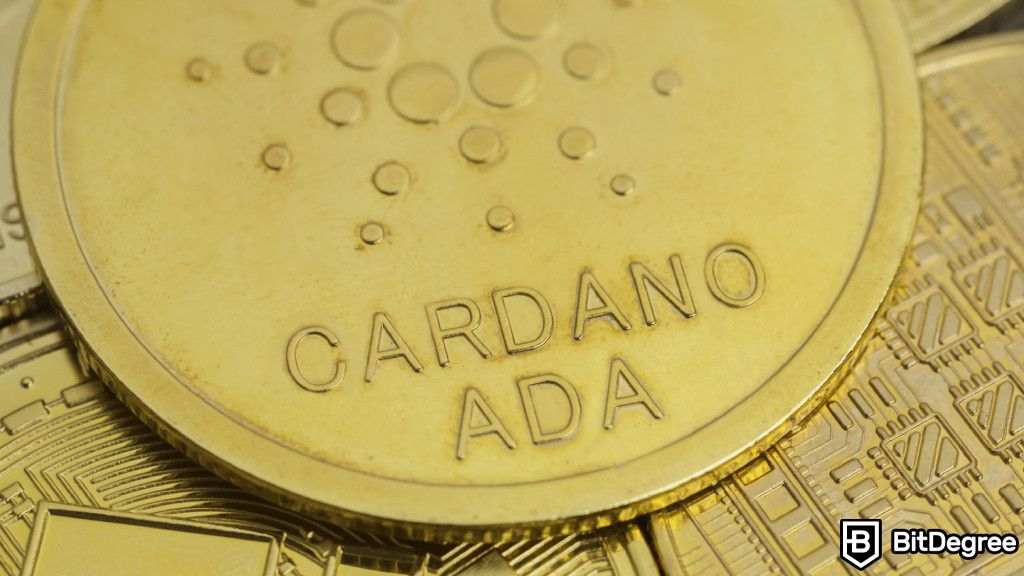Key Takeaways
- Cardano is a Proof-of-Stake public blockchain that allows you to earn rewards by staking its native coin, ADA;
- To stake ADA, you can either run your own stake pool or delegate your coins to existing operators;
- Cardano doesn't require you to lock up your coins so you can access them anytime.
Stop overpaying - start transferring money with Ogvio. Join the waitlist & grab early Rewards NOW! 🎁
If you're looking to generate income from your idle assets, Cardano might be the answer. By staking Cardano, you can earn potential rewards while contributing to the network's security and operations.
One key benefit of staking Cardano is its flexibility and liquidity. Your staked assets remain accessible, allowing you to trade or transact them even while they're staked. And with options like staking through a wallet application like Ledger Live or using popular exchanges like Kraken, getting started has never been easier.
Curious to learn more? Let’s explore how to stake Cardano and help strengthen the network's security while earning rewards along the way!

Did you know?
Subscribe - We publish new crypto explainer videos every week!
How to Buy Crypto SAFELY With a Credit Card (Animated)


Table of Contents
- 1. What is Cardano?
- 2. How Cardano Proof-of-Stake Works
- 2.1. Cardano Staking Pools
- 2.2. Operating VS Delegating Your Stake
- 3. How to Stake Cardano
- 3.1. How to Stake Cardano on Ledger Live
- 3.2. How to Stake Cardano on Kraken
- 4. How to Unstake Cardano
- 4.1. How to Unstake Cardano on Ledger Live
- 4.2. How to Unstake Cardano on Kraken
- 5. Cardano Staking: Benefits and Risks
- 5.1. Potential Benefits of Staking Cardano
- 5.2. Potential Risks of Staking Cardano
- 6. Best Practices for Staking Cardano
- 7. Conclusions
What is Cardano?
Before diving into Cardano staking and its details, let's take a closer look at the network itself.
Latest Deal Active Right Now:Launched in 2015 by Charles Hoskinson, a co-founder of Ethereum, Cardano has quickly risen to prominence as a pioneering blockchain. The network’s standout feature is its use of a Proof-of-Stake (PoS) protocol, a notably more eco-friendly alternative to the traditional Proof-of-Work (PoW).
One of Cardano's core principles is rigorous research. Every new technology is typically peer-reviewed, allowing independent experts to analyze and critique ideas before implementation. This focus on meticulous approaches aims to identify and address potential issues proactively, enhancing the blockchain's stability and durability.
At the core of Cardano lies ADA, the platform's native cryptocurrency. ADA lets users conduct secure and global transactions, bypassing the need for banks or intermediaries.
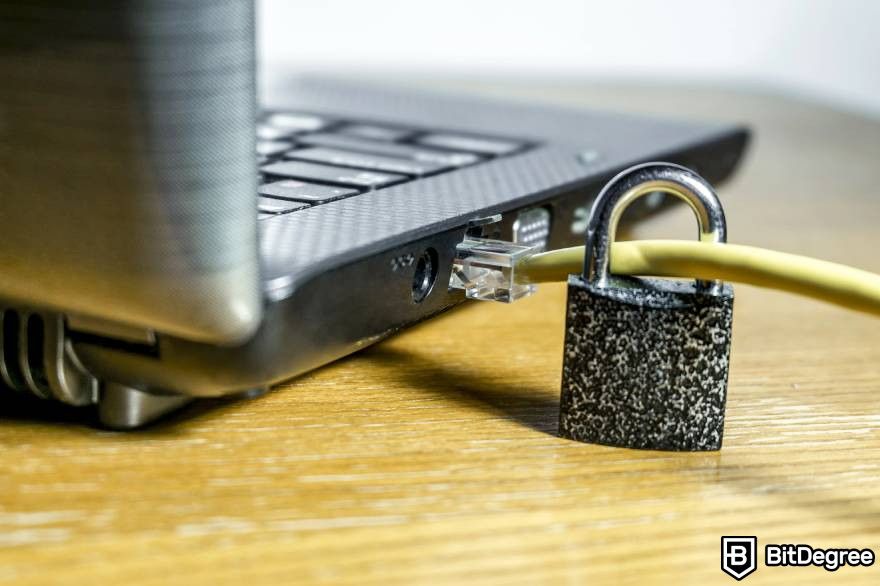
Cardano's blockchain permanently records every ADA transaction, ensuring transparency and security. This robust technology supports peer-to-peer (P2P) transactions and provides a solid foundation for developing decentralized applications (dApps) across various industries.
However, owning ADA is more than just having a crypto asset. It opens the door to Cardano staking, a process we'll explore in detail in the next section.
How Cardano Proof-of-Stake Works
Like many PoS blockchains, Cardano staking incentivizes users to participate in the network's validation and security process. However, the network introduces a unique and intriguing twist with its Ouroboros protocol.
Serving as the core of Cardano network, Ouroboros ensures its security, sustainability, and smooth operation. It's designed to be scalable and secure while using less energy. Plus, it takes pride as the very first blockchain protocol to be developed based on peer-reviewed research.
Ouroboros integrates advanced technology and principles from behavioral psychology and economics. As a result, it provides verified security guarantees, facilitating the creation of global, decentralized networks[1].
How Cardano Proof-of-Stake works through Ouroboros? Well, the protocol operates by dividing the chains into ”epochs” (five-day periods) and “slots” (one-second intervals).
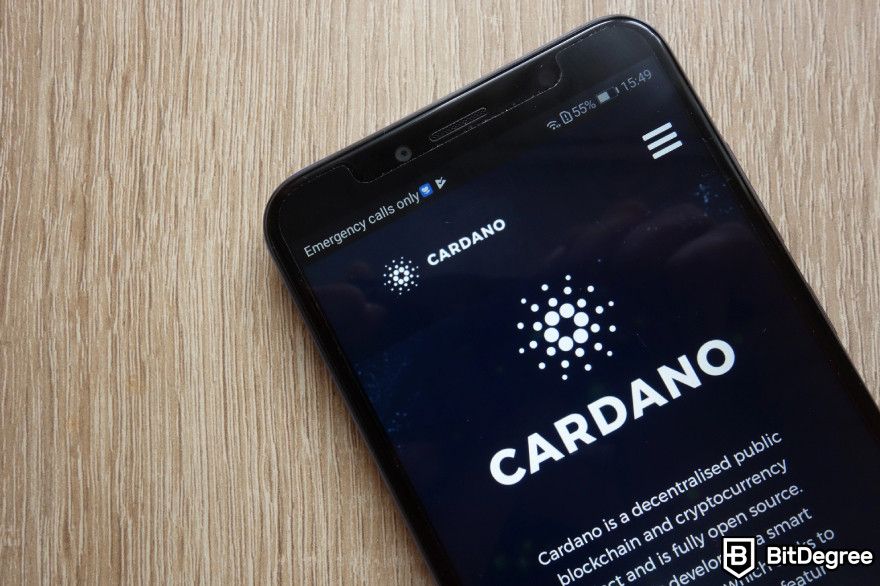
The network algorithm randomly picks a node as a leader for each slot. However, participants who hold higher stakes have a better chance of being selected to generate new blocks. This approach helps decentralized networks continuously support emerging markets.
Ouroboros also uses a security measure called a "settlement delay" to prevent illegal tampering within the system. Each slot leader treats recent blocks as temporary.
Then, the system confirms a block as permanent only after adding a specified number of subsequent temporary blocks. This setup ensures stakeholders stay connected with the blockchain even if they temporarily go offline, as long as it's within the settlement delay period.
Cardano Staking Pools
Another term important to understand how Cardano Proof-of-Stake works is a staking pool. Essentially, it's a collective effort where participants combine their ADA tokens. The more ADA a pool holds, the higher its chance of being selected to validate a transaction and earn rewards.
For individuals with limited ADA, staking alone might not be very productive. Users can combine their staked ADA with others by joining a staking pool, creating a more powerful pool. This significantly increases the pool's chances of being chosen to validate a block and generate rewards.
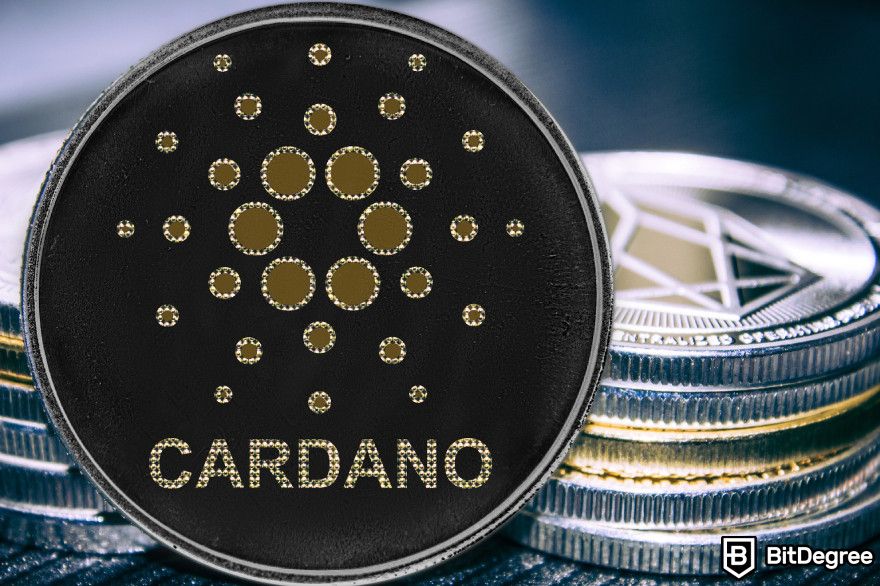
When a pool successfully validates a block, the rewards are distributed proportionally among its members. The more ADA you contribute to the pool's total stake, the larger your share of the rewards will be.
However, while staking pools significantly improve your chances of earning rewards compared to individual staking, a payout isn't guaranteed. The process of selecting which pool validates a block remains random.
Operating VS Delegating Your Stake
Now that you've understood the role of stake pools in Cardano's network, let’s explore your options. When it comes to staking your ADA, you have two main options:
Operating Your Stake Pool
Operating a stake pool requires setting up and maintaining a node on the Cardano network. This process demands significant technical expertise, ongoing commitment, and hardware investment. Here are some key points to consider:
- Significant Technical Expertise: Setting up a stake pool requires familiarity with blockchain technology, server management, and network security. You'll need to configure the node, ensure its continuous operation, and protect it from potential threats.
- More Considerable Initial Investment: Running a stake pool involves costs such as server fees, power consumption, decent computers, and potentially hiring technical help.
- Greater Responsibility and Commitment: Operating a stake pool requires greater responsibility and commitment, as it is a continuous task. You'll need to monitor its performance, apply software updates, and handle any technical issues that may arise.
It's worth noting that you can earn more rewards as a stake pool operator. However, you must attract delegators to your pool to increase your stake and chances of being selected to produce blocks.
Delegating Your Stake
If you prefer a hands-off approach, delegating your ADA to an existing stake pool is a more practical option. These pools let you delegate your stake to a group that brings together stakes from several people, creating a shared pool of resources.

By doing this, many people can combine their stakes to meet the minimum requirements needed for the validator to join the validator set. Here’s what you need to know:
- Easier to Do: Delegating your stake is pretty straightforward. You don't have to deal with the technicalities of running a node or managing a server.
- Lower Risk: By not running a stake pool yourself, you steer clear of associated costs and risks. This way, you can still earn rewards without investing upfront in equipment or handling ongoing maintenance.
- Better Flexibility: Delegating your stake is flexible and doesn't lock you into a long-term commitment. You can easily switch to a different stake pool if you're not satisfied with the performance or fees of your current one.
If you're new to the scene, I suggest you should consider delegating your tokens to an existing stake pool rather than running your own. It's much easier and a great way to start. So, let's dive into exploring how to stake Cardano next!
How to Stake Cardano
Now that we've gone over the important details about the network, let's dive into the Cardano staking process. These days, you have plenty of options for staking Cardano, whether it's through your wallet or an exchange. Let me show you how to do it.
How to Stake Cardano on Ledger Live
One of the safest ways to stake Cardano is through a hardware wallet like Ledger. Not only is it secure, but it’s also incredibly user-friendly, thanks to its handy app, Ledger Live, which makes the staking process seamless.
If you want to become a delegator using the app, just follow these few simple steps. But first, make sure your Ledger wallet is all set up and ready to go before you jump into it.
Step 1: Download and Install the Ledger Live App
First, download and install the Ledger Live app according to your device's operating system. For this guide, I'll be using the Ledger Live app for Windows. Follow the simple instructions to install the app and open it once it's complete.

Step 2: Connect and Install the Cardano App
Connect your Ledger device and unlock it. Navigate to 'My Ledger', then head to 'App Catalog'. Search for 'Cardano (ADA)' and select [Install] once you find it.
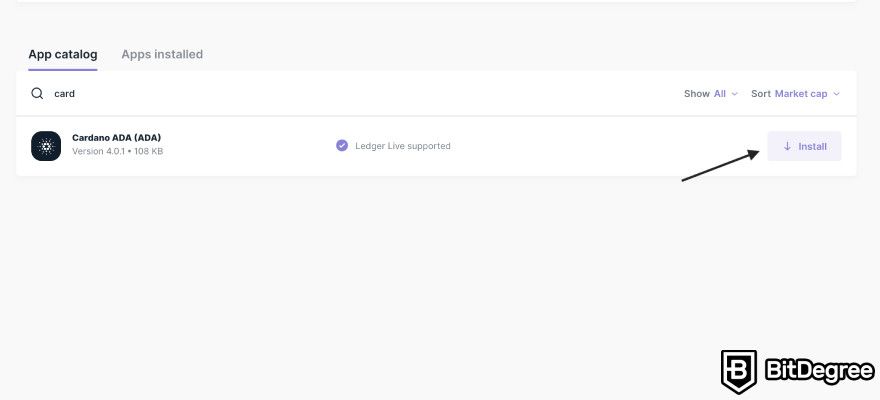
Step 3: Add a Cardano Account in Ledger Live
In Ledger Live, go to 'Accounts' and then select [Add accounts]. Choose [Cardano (ADA)] from the drop-down list and click [Continue]. Connect your device to Ledger Live to unlock it and finalize the process. After it's completed, open the Cardano app on your device and select [Add account].

Step 4: Initiate the Cardano Staking
In your Cardano account on Ledger Live (usually located in the upper left corner), select the [Stake] option and click [Continue] when prompted.
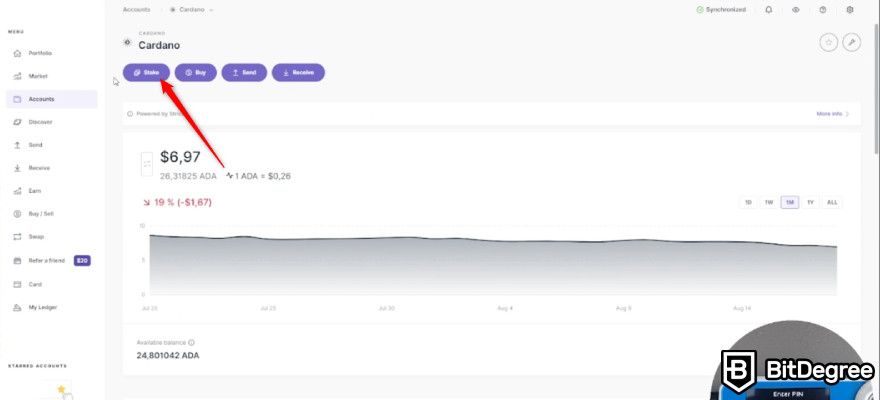
Step 5: Choose a Validator
Ledger Live might present 'Ledger by Figment' as the default validator option. You can choose this validator or select a different one. Click [Continue] after selecting your validator.
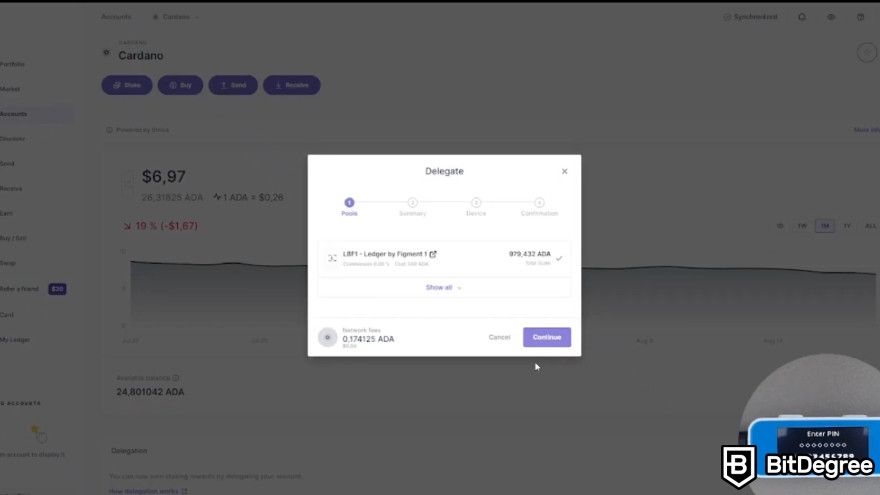
Step 6: Review Transaction Details
Carefully review the transaction details displayed on your Ledger Live app. If everything appears correct, click [Continue].
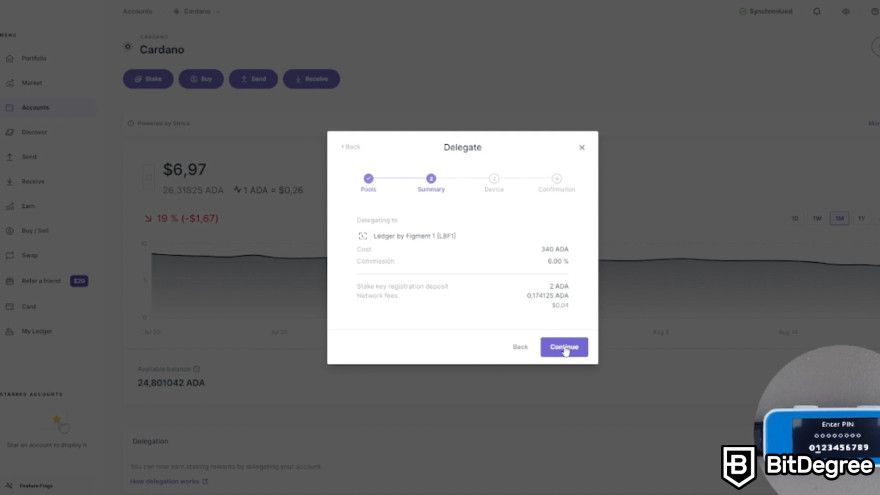
Step 7: Verify and Sign Transaction
Connect and unlock your Ledger device, then open the [Cardano (ADA)] app. Once you're ready to proceed, find the screen displaying 'Confirm Transaction'. Simultaneously press both buttons on your Ledger device to sign and broadcast the transaction.

Step 8: Confirmation and Final Steps
When you see the confirmation message for successful delegation, click [Close] on Ledger Live. After the network confirms your transaction, your delegated ADA balance will appear in the 'Delegation' section of your Cardano account in Ledger Live.
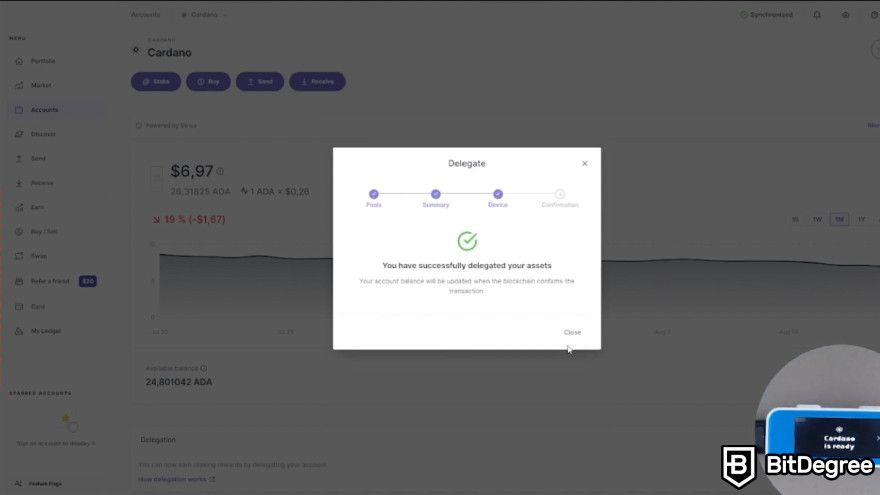
That's it! You've successfully staked your ADA. Now, you can sit back and watch your Cardano staking rewards grow.
How to Stake Cardano on Kraken
If you don't have a hardware wallet, no need to worry! You can also easily stake Cardano on a crypto exchange like Kraken. The process is quite simple and straightforward. Here's how to do it:
Step 1: Head to the Kraken website and log in to your account. If you don’t have an account yet, sign up and complete the necessary verification steps.
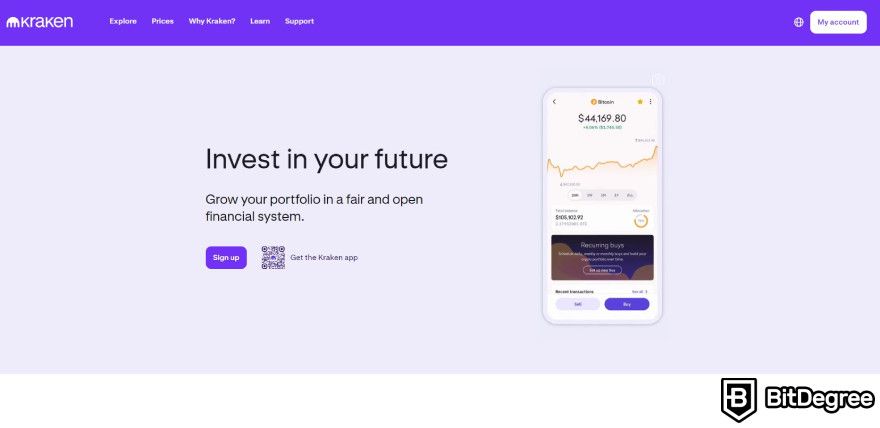
Step 2: Once your account is all set up, deposit ADA into your Kraken account or buy it directly on the platform.
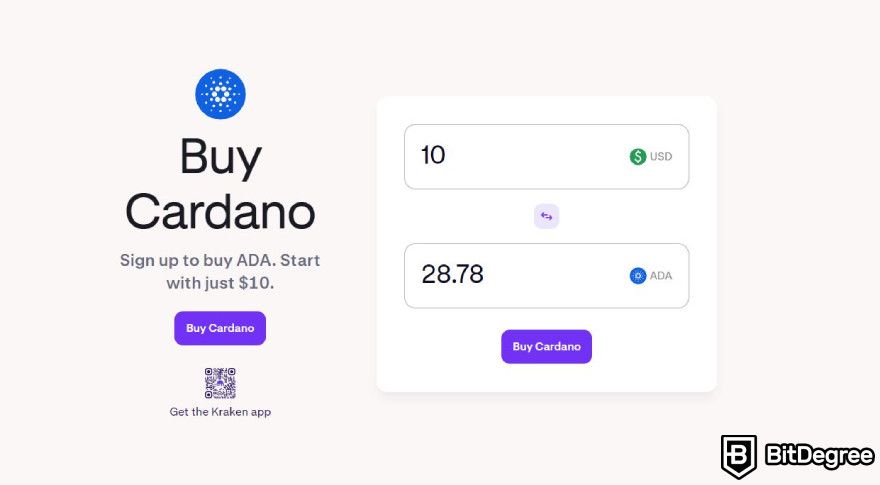
Step 3: Go to your Kraken Pro dashboard and click on the “Earn” tab.

Step 4: Pick Cardano from the list and hit [Stake].
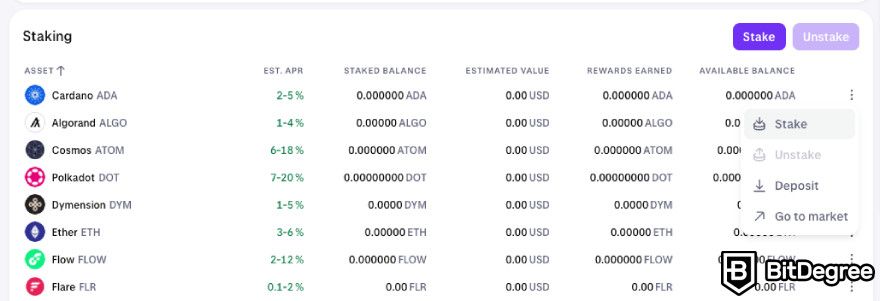
Then, you'll just have to enter the amount of ADA you want to stake and click [Stake] once more.
That’s it! Your ADA is now staked, and you can easily track your Cardano staking rewards from the user-friendly dashboard. If you want to learn more about Kraken staking, check out this article.
When you receive the rewards, they will be automatically added to your balance. The amount you get depends on several factors, including overall network performance, the amount of ADA you stake, and the operator’s fee.
For example, if you’re staking Cardano with Ledger through Figment, your returns will follow the Cardano annual percentage rate (around 2-3%). Figment will also deduct a commission fee before you receive your final payout.
Typically, you’ll see these rewards added to your balance at the end of each epoch, roughly every five days. This deposit reflects your earnings from the previous epoch and will show up instantly in your account's 'Rewards' section.
However, if this is your first time staking Cardano, you may have to wait a bit for your initial rewards. Depending on when you delegated your ADA within the current epoch, they can take up to 20-25 days to appear.
How to Unstake Cardano
One of the significant advantages of Cardano staking is its flexibility. Unlike other protocols, Cardano doesn't impose a lock-up period on your staked ADA. This means you can withdraw your funds or "unstake" them whenever needed. For consistency's sake, let's continue with Ledger Live and Kraken.

Did you know?
Subscribe - We publish new crypto explainer videos every week!
What Are Flash Loans? TOP Ways to Make Passive Income Explained


How to Unstake Cardano on Ledger Live
Unstaking your ADA coins on Ledger Live is just as easy as staking them. Here's a simple guide on how to do it:
Step 1: Open the Ledger Live app and navigate to the 'Accounts' section. Then, select your [Cardano] account.

Step 2: Within your account details, locate the 'Delegation' section, where you'll find your currently delegated ADA balance. Select the [...] option and click on [End delegation].
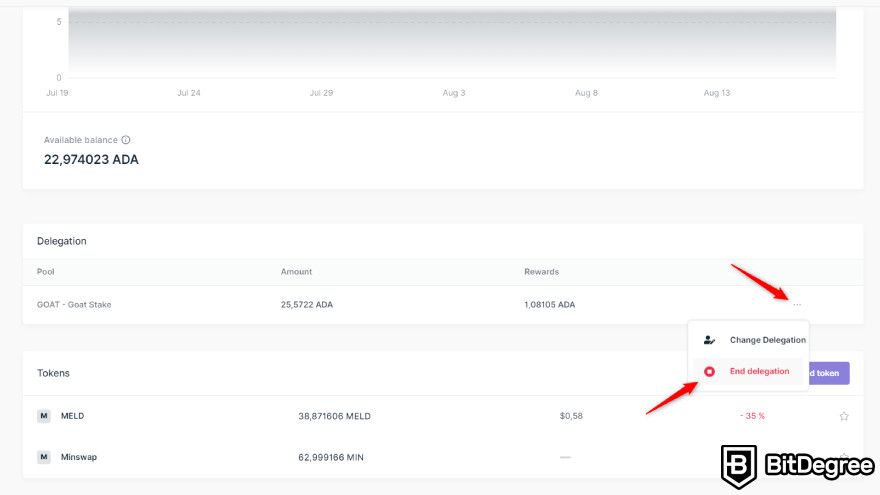
Step 3: Select [Continue] when prompted to proceed with the unstaking process. You'll then be required to open the [Cardano (ADA)] app on your Ledger device.
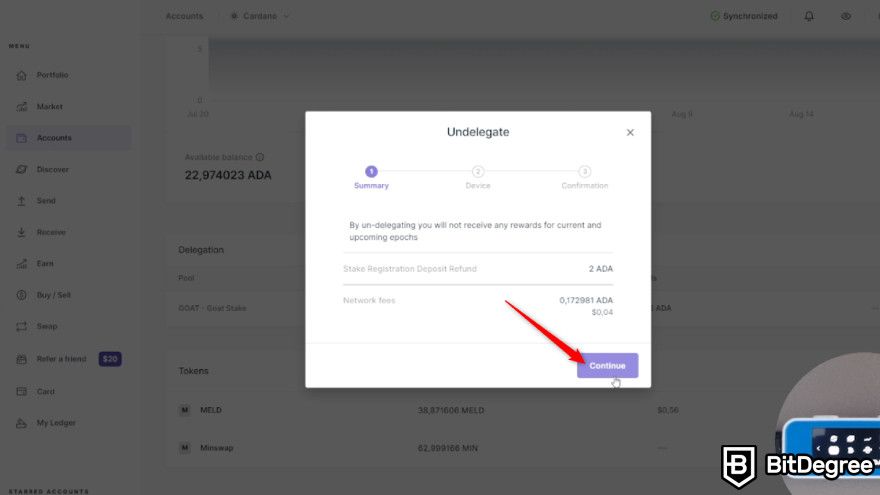
Step 4: Your Ledger device will display the unstaking transaction details. After reviewing it, navigate to the 'Confirm transaction' screen and simultaneously press both buttons on your Ledger device.
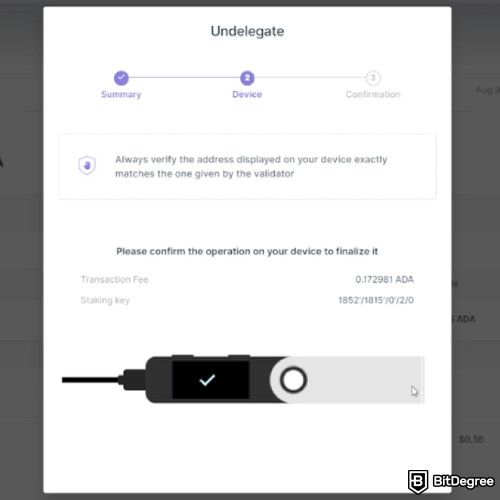
Step 5: A confirmation message will appear on Ledger Live. Then, select [Close].
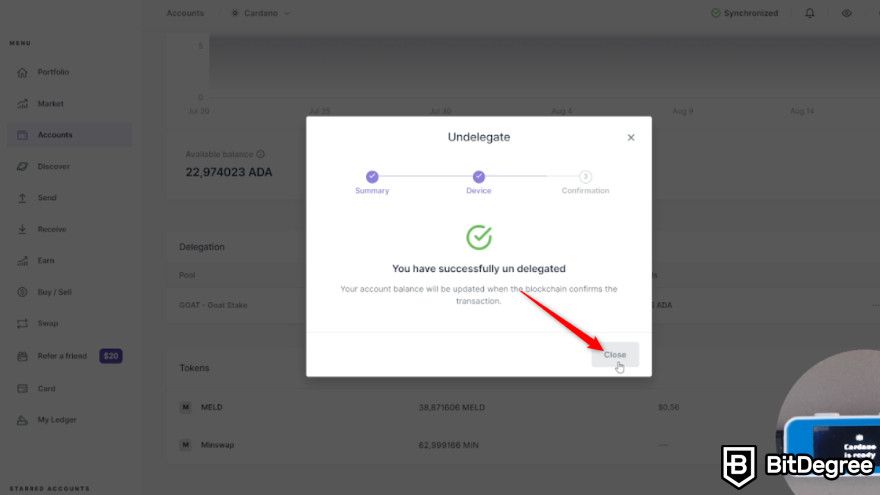
How to Unstake Cardano on Kraken
Unstaking your Cardano on Kraken is also a quick and straightforward process that may only take a few minutes. Here’s how to do it in a few easy steps:
Step 1: Head over to the "Earn" section on the Kraken Pro dashboard.
Step 2: Select Cardano in the list, click on the three dots next to it and then click [Unstake].
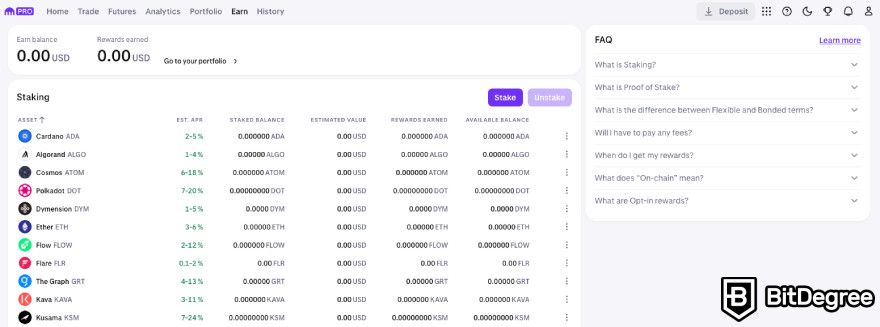
Step 3: Enter the amount you want to unstake and click [Unstake] to proceed.
After you have unstaked your ADA, you have the option to withdraw or restake it to continue earning passive income. When you restake, your rewards will increase your total staked amount, boosting your future rewards.
This process lets you grow your holdings without additional investments. However, it's important to remember that rewards are not guaranteed, and you should always be aware of the risks involved.
Cardano Staking: Benefits and Risks
Cardano staking offers a good opportunity to earn passive income on your holdings. However, it's essential to consider both the benefits and the potential risks. To help you make an informed decision, let's explore the key advantages and disadvantages of staking Cardano.
Potential Benefits of Staking Cardano
Cardano staking offers an appealing opportunity to generate passive income while actively contributing to the network's growth. Let's explore some of its potential benefits.
✓ A Chance to Generate Passive Income
Staking your ADA tokens allows you to earn rewards by participating in Cardano's security system. Instead of letting your ADA sit idle, you can put them to work and receive more ADA tokens as rewards.

These rewards are distributed regularly, allowing your ADA holdings to grow passively without active trading. It's similar to earning interest on your savings account but on a relatively secure and transparent blockchain platform.
Keep in mind that returns from staking can be influenced by the network's performance. Also, the more participants there are staking, the more rewards can be diluted. So, it's important to consider these factors before deciding to stake your holdings.
✓ Freedom to Unstake Anytime
Another significant advantage of Cardano staking is its focus on maintaining liquidity for your ADA. You can withdraw your delegated tokens anytime, giving you greater control over your investment strategy.
Additionally, by restaking your ADA rewards, you can leverage the power of compounding to grow your passive income over time. This method allows you to potentially increase your holdings without the need for additional investments.

However, I suggest not withdrawing your ADA rewards too frequently, especially if you have a small amount delegated. Transaction fees can take up a significant portion of your rewards and, in some cases, might even exceed the amount you withdraw!
✓ Lower Risk Compared to Trading
For active traders, the cryptocurrency market can often feel like a rollercoaster ride. While trading actively can lead to higher returns, it demands constant attention, a higher risk tolerance, and a significant time commitment.
Cardano staking provides a more stable and passive income with reduced risk. This steady income stream makes staking appealing for those looking at the cryptocurrency market from a long-term perspective.
It also takes you out of the wild swings of daily trading. This benefit reduces your risk exposure and keeps you from making impulsive decisions based on short-term market emotions.
✓ Strengthening Blockchain Security and Efficiency
Staking Cardano goes beyond just earning rewards. You actually get to be a part of securing the whole network. When you delegate your ADA, you contribute to a giant pool of stakes that validates transactions and keeps the blockchain safe. It's like a team effort to ensure everything runs smoothly and nobody messes with the system.

Plus, staking helps make Cardano more decentralized. Instead of relying on some significant entity to keep things secure, staking allows regular users to be a key part of the network's safety.
Cardano staking is a convenient way to help secure the network and earn passive income. You can also withdraw your stake whenever you want, giving you full control over your investment. However, keep in mind that there are some risks involved as well.

- Secure and reliable
- Accepts fiat currencies
- Lots of trading options
- Reputable exchange
- Accepts fiat currencies
- Offers various trading options

- Huge trading variety
- Regulation-compliant around the globe
- Fair trading fees
- Beginner-friendly
- A wide array of features
- Vast number of different crypto coins & tokens

- Beginner-friendly
- Secure
- Decent trading and withdrawal fees
- Crypto.com Visa Card
- Automated tools & bots
- Ecosystem synergy with CRO
Potential Risks of Staking Cardano
While staking Cardano offers benefits, it's crucial to understand the potential risks. Before staking your holdings, let's explore key considerations to keep in mind.
✗ Volatility Risks
While Cardano staking offers the potential for passive income, it's vital to remember that the cryptocurrency market is inherently volatile. The value of your staked coins and staking rewards could fluctuate significantly. If the price of ADA drops even slightly, it may affect your APY rewards compared to what you initially expected.
So, before staking Cardano, it's best to consider this inherent volatility and adopt a long-term investment perspective. Understand that short-term fluctuations are normal and shouldn't impact your long-term goals.
✗ Fluctuating Earnings
It's important to understand that earnings will not be the same in every epoch. Several factors influence this variability, with stake pool performance and fees being the most significant.
By carefully considering these factors, especially when selecting a stake pool, you can effectively manage your expectations for the rewards. This approach helps you avoid disappointment and make better decisions, ensuring a more satisfying staking experience.
✗ Fraudulent Stake Pool Operators
Cardano staking requires trusting pool operators to act as honest validators. The network's security depends on having the majority of nodes controlled by trustworthy participants.

However, there's a risk of encountering malicious pool operators. These individuals could exploit the pool for personal gain and threaten the network's security.
Protecting your assets is essential, but selecting a reputable and secure staking pool is equally important. Doing so ensures your ADA remains safe and supports the network's integrity.
✗ Compliance Issues
Crypto staking can be an exciting opportunity, but it's important to note that there’s some uncertainty around regulations. As staking becomes more popular and financially significant, governments and regulatory bodies worldwide are paying closer attention to it.

For instance, the US Securities and Exchange Commission (SEC) has announced that it will closely monitor cryptocurrencies, especially those considered securities. This increased scrutiny has led some platforms to stop offering staking services altogether.
Given the changing regulatory landscape, it's crucial to be proactive. Take the time to thoroughly research the regulations in your region to understand any compliance requirements that may apply to you as a staker.
Best Practices for Staking Cardano
Cardano staking provides an excellent opportunity to earn passive income, but it comes with its own risks. You should follow best practices during the staking process to minimize these risks. Here are some tips to ensure a smooth and secure staking experience:
Tip 1: Research reliable staking pools.
Before delegating your ADA, you must understand that you play a vital role in the process. Conducting thorough research to find reputable and high-performing stake pools is key. Here are the factors to consider when choosing:
- Fees and Returns: Balancing fees with performance is essential. While lower fees are attractive, prioritize the pool's overall performance.
- Proven Performance: Select pools consistently produce minimal orphaned blocks to ensure reliable rewards.
- Pool Saturation: Avoid overly saturated pools to maximize your staking rewards.
Take your time to analyze and research each potential stake pool thoroughly. Once you've chosen a pool, regularly monitor its performance to ensure it continues to meet your needs and expectations.
Tip 2: Employ strategic diversification.
Like with any investment, diversification is also important to consider when staking. Spreading your holdings across various assets helps mitigate the risk of significant losses if the price of a single cryptocurrency drops.
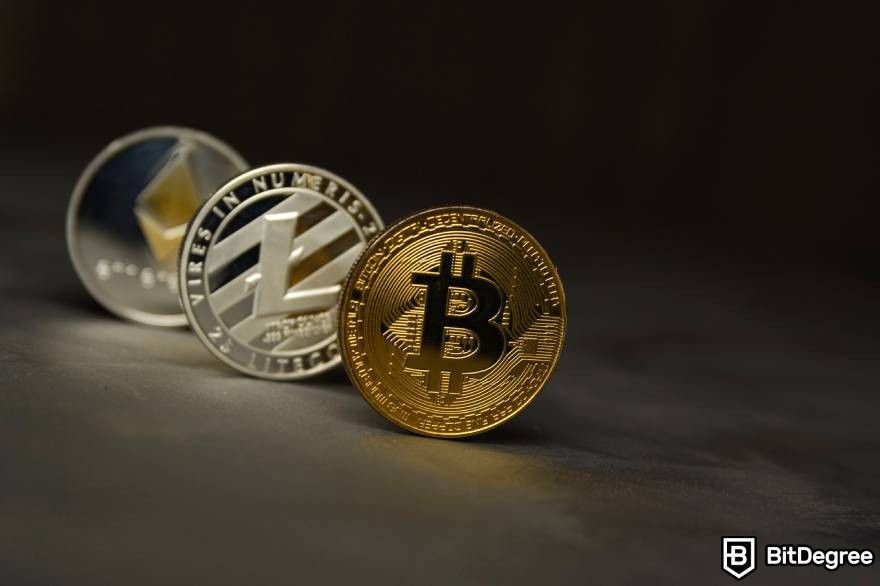
Staking can be a great way to earn passive crypto income. However, cryptocurrencies are more volatile than traditional currencies. That means the price can swing wildly, and you could lose money.
To manage this risk, avoid staking your savings with only one coin. Consider diversifying your portfolio by staking other options or holding promising cryptocurrencies with solid growth potential.
This broader approach not only spreads your risk but also has the potential to increase your overall returns. As a result, you’ll sleep better at night, knowing your investments are on a more stable footing.
Tip 3: Stay informed.
The crypto space moves fast, so staying informed is important if you decide to stake your holdings. To keep up with the latest developments, make it a habit to follow reputable news sources and industry experts on social media. Additionally, bookmark the official websites of related staking platforms to stay updated on any changes related to staking or regulations.

Consider joining online forums and communities dedicated to the Cardano ecosystem. Engaging in these spaces allows you to participate in real-time discussions, ask questions from experienced users, and gain valuable insights.
Staking Cardano can be a secure and rewarding experience, but it requires staying updated on the latest developments. Keep yourself informed to ensure you make the most of your staking journey.
Tip 4: Improve your security measures.
Security should always be your top priority, especially in the ever-evolving digital landscape where cybercrime lurks. Here are some essential practices to minimize vulnerabilities and safeguard your investment:
- Regular Software Updates: Keep your wallet software and pool delegation tools updated. These updates often include critical patches that prevent potential exploits and ensure robust staking security.
- Phishing Prevention: Stay vigilant against phishing scams. Never disclose wallet information or login credentials in response to unsolicited emails, messages, or websites. Only engage with verified platforms to verify authenticity.
- Hardware Wallets for Added Security: Consider using a hardware wallet, like Ledger Nano X, to store your assets safely. Hardware wallets provide top-level security by keeping sensitive data offline, significantly reducing the risk of malware and hacking attempts[2].
By following these best practices, you'll be well-equipped to participate in Cardano staking confidently. This proactive approach minimizes risks and allows you to focus on maximizing your potential returns.
Conclusions
Cardano staking is a solid method to earn passive income while boosting the network's security and stability. You can achieve this by either running your stake pool or delegating your ADA to existing pools, which is a more effortless option for most.
Staking Cardano is also quite accessible, thanks to options like Ledger and Kraken, which offer intuitive interfaces and robust security features that make the whole process seamless and, most importantly, secure.
While staking is generally considered safer than other crypto investments, it still carries certain risks, including price volatility, fraudulent stake pool operators, and potential compliance issues. To mitigate these risks, it's essential to spread your holdings, thoroughly research staking pools, and stay informed about market trends and regulatory updates.
The content published on this website is not aimed to give any kind of financial, investment, trading, or any other form of advice. BitDegree.org does not endorse or suggest you to buy, sell or hold any kind of cryptocurrency. Before making financial investment decisions, do consult your financial advisor.
Scientific References
1. F. Mellentin: 'Ouroboros: Cardano's proof-of-stake consensus pprotocol';
2. S. Houy, P. Schmid, A. Bartel: 'Security aspects of cryptocurrency wallets—a systematic literature review'.
